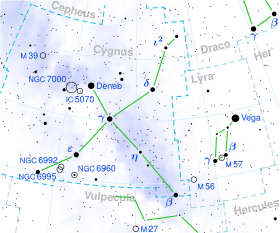Xi Cygni
| Observation data Epoch J2000 Equinox J2000 | |
|---|---|
| Constellation | Cygnus |
| Right ascension | 21h 04m 55.86s[1] |
| Declination | +43° 55′ 40.272″[1] |
| Apparent magnitude (V) | 3.73[2] |
| Characteristics | |
| Spectral type | K4:Ib- + A1.5V[3] |
| U−B color index | +1.78[2] |
| B−V color index | +1.66[2] |
| Astrometry | |
| Radial velocity (Rv) | -19.10[4] km/s |
| Proper motion (μ) | RA: +10.062[1] mas/yr Dec.: +0.861[1] mas/yr |
| Parallax (π) | 2.8363 ± 0.1269 mas[1] |
| Distance | 1,150 ± 50 ly (350 ± 20 pc)[1] |
| Absolute magnitude (MV) | −4.3/+1.3[3] |
| Orbit[5] | |
| Period (P) | 6,750 ± 200 days |
| Semi-major axis (a) | ~766 R☉ |
| Eccentricity (e) | 0.25 ± 0.07 |
| Inclination (i) | ~50° |
| Details[6] | |
| Primary | |
| Mass | ~8[5] M☉ |
| Radius | 220.09+9.64 −10.56 R☉ |
| Luminosity | 9889±964 L☉ |
| Surface gravity (log g) | 0.89 cgs |
| Temperature | 3,878±33 – 4,031 K |
| Metallicity [Fe/H] | −0.26 dex |
| Secondary | |
| Mass | ~2.5[5] M☉ |
| Other designations | |
| Database references | |
| SIMBAD | data |
ξ Cygni (Latinised as Xi Cygni) is a spectroscopic binary star in the constellation Cygnus, made up of a K-type supergiant star (primary) and an A-type star (secondary). Its apparent magnitude is 3.73, making it readily visible to the naked eye, and it is located around 350 parsecs (1,100 ly) away.
Characteristics
[edit]The system contains two stars which orbit every 18 years in a mildly eccentric orbit. The primary star is a supergiant with a spectral type of around K4, while the secondary is an A-type main-sequence star with a spectral type of A1.5. Stellar winds from the supergiant have been measured at around 50 km/s, but with variations in speed and individual line strengths.[5]
The distance to Xi Cygni is of about 350 parsecs (1,100 ly), based on parallax measurements.[1] At this distance, the apparent magnitude is diminished by 0.16 magnitudes.[6]
ξ Cygni is in the Kepler spacecraft's field of view but no planets have been detected.[7]
Gallery
[edit]-
H-alpha RGB amateur image of ξ Cygni, center star, at edge of NGC7000
-
NGC 7000 (North America Nebula). ξ Cygni is the bright star on the left.
References
[edit]- ^ a b c d e f g Vallenari, A.; et al. (Gaia collaboration) (2023). "Gaia Data Release 3. Summary of the content and survey properties". Astronomy and Astrophysics. 674: A1. arXiv:2208.00211. Bibcode:2023A&A...674A...1G. doi:10.1051/0004-6361/202243940. S2CID 244398875. Gaia DR3 record for this source at VizieR.
- ^ a b c Ducati, J. R. (2002). "VizieR Online Data Catalog: Catalogue of Stellar Photometry in Johnson's 11-color system". CDS/ADC Collection of Electronic Catalogues. 2237: 0. Bibcode:2002yCat.2237....0D.
- ^ a b Ginestet, N.; Carquillat, J. M. (2002). "Spectral Classification of the Hot Components of a Large Sample of Stars with Composite Spectra, and Implication for the Absolute Magnitudes of the Cool Supergiant Components". The Astrophysical Journal Supplement Series. 143 (2): 513. Bibcode:2002ApJS..143..513G. doi:10.1086/342942.
- ^ Famaey, B.; et al. (January 2005), "Local kinematics of K and M giants from CORAVEL/Hipparcos/Tycho-2 data. Revisiting the concept of superclusters", Astronomy and Astrophysics, 430 (1): 165–186, arXiv:astro-ph/0409579, Bibcode:2005A&A...430..165F, doi:10.1051/0004-6361:20041272, S2CID 17804304
- ^ a b c d Reimers, D.; Schroeder, K.-P. (1989). "Observations of modulation and phase displacement of the stellar wind in six red giant spectroscopic binaries". Astronomy and Astrophysics. 214: 261. Bibcode:1989A&A...214..261R.
- ^ a b Baines, Ellyn K.; Thomas Armstrong, J.; Clark, James H.; Gorney, Jim; Hutter, Donald J.; Jorgensen, Anders M.; Kyte, Casey; Mozurkewich, David; Nisley, Ishara; Sanborn, Jason; Schmitt, Henrique R.; van Belle, Gerard T. (2021-10-15). "Angular Diameters and Fundamental Parameters of Forty-four Stars from the Navy Precision Optical Interferometer". The Astronomical Journal. 162 (5): 198. arXiv:2211.09030. Bibcode:2021AJ....162..198B. doi:10.3847/1538-3881/ac2431. ISSN 0004-6256.
- ^ Molenda-Żakowicz, J.; Sousa, S. G.; Frasca, A.; Uytterhoeven, K.; Briquet, M.; Van Winckel, H.; Drobek, D.; Niemczura, E.; Lampens, P.; Lykke, J.; Bloemen, S.; Gameiro, J. F.; Jean, C.; Volpi, D.; Gorlova, N.; Mortier, A.; Tsantaki, M.; Raskin, G. (2013). "Atmospheric parameters of 169 F-, G-, K- and M-type stars in the Kepler field". Monthly Notices of the Royal Astronomical Society. 434 (2): 1422. arXiv:1306.6011. Bibcode:2013MNRAS.434.1422M. doi:10.1093/mnras/stt1095. S2CID 59269553.




